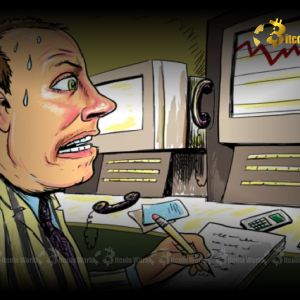BitcoinWorld US Dollar Forecast: Crucial Weakness Expected in H2 2025 Are you a cryptocurrency enthusiast keeping a close eye on global economic shifts? Then buckle up, because a significant shift in the traditional financial landscape could be on the horizon. Recent predictions from UBS, a leading global financial services company, suggest that the US dollar forecast points towards likely losses in the second half of 2025. This isn’t just about currency exchange rates; it has profound implications for every asset class, including, crucially, the crypto market. Understanding this potential dollar weakness is key to navigating the financial waters ahead. Decoding the Anticipated US Dollar Weakness: What’s Driving It? The U.S. dollar, often seen as a safe haven and the world’s reserve currency, doesn’t typically face predictions of sustained decline without substantial underlying reasons. UBS’s outlook isn’t just a casual observation; it’s a meticulously calculated projection based on a confluence of macroeconomic factors. So, what exactly is expected to fuel this anticipated dollar weakness ? Several key drivers are typically cited when economists discuss currency depreciation. For the U.S. dollar, these often include: Monetary Policy Divergence: The Federal Reserve’s interest rate decisions play a pivotal role. If other major central banks (like the European Central Bank or the Bank of Japan) begin to hike rates more aggressively or maintain higher rates for longer than the Fed, it can make their respective currencies more attractive to investors, leading to capital outflows from the U.S. and weakening the dollar. Conversely, if the Fed cuts rates faster or deeper than its peers, the dollar’s yield advantage diminishes. Inflation Outlook: Persistent or higher-than-expected inflation in the U.S. could erode the purchasing power of the dollar, making it less appealing. While central banks aim to control inflation, an inability to do so effectively can undermine currency strength. Economic Growth Differentials: If economic growth outside the U.S. accelerates significantly relative to U.S. growth, it can attract investment to those regions, again diverting capital away from dollar-denominated assets. A robust global recovery, particularly in Europe or Asia, could shift the balance. Trade Deficits: A large and persistent U.S. trade deficit means the country is importing more goods and services than it exports. This implies a continuous outflow of dollars to pay for these imports, which can put downward pressure on the currency’s value. Geopolitical Factors and Global Risk Appetite: While the dollar often strengthens during times of global uncertainty (as a safe haven), prolonged periods of stability or a shift in geopolitical power dynamics could reduce the need for dollar-denominated assets, leading to a reallocation of global reserves and investments. What Does the UBS Economic Outlook Reveal for H2 2025? UBS, known for its in-depth market analysis, is not alone in predicting shifts in global currencies, but its specific timing and conviction regarding the US dollar forecast for H2 2025 warrants attention. Their UBS economic outlook typically considers a broad spectrum of indicators, including: Interest Rate Trajectories: UBS likely anticipates the Federal Reserve reaching a point where it will either pause its rate hikes or begin cutting rates by H2 2025, potentially at a faster pace than other major central banks. This would diminish the dollar’s yield appeal. Inflation Normalization: A projected return to more normalized inflation levels in the U.S. could reduce the urgency for a hawkish Fed, allowing for more accommodative monetary policy, which tends to weaken a currency. Global Growth Rebalancing: The bank may foresee a rebalancing of global economic growth, with other major economies (like the Eurozone or China) potentially catching up or even outpacing U.S. growth by mid-2025, making their assets more attractive. Fiscal Policy and Debt Concerns: While less direct, ongoing debates about U.S. fiscal policy, national debt, and potential government shutdowns can add layers of uncertainty, contributing to a cautious outlook on the dollar. It’s important to remember that these are forecasts, subject to change based on evolving economic data and unforeseen global events. However, a major institution like UBS making such a call suggests a high degree of confidence in these underlying trends. How Might Global Currency Trends Shift with a Weaker Dollar? A significant weakening of the U.S. dollar doesn’t happen in a vacuum; it inevitably impacts global currency trends . The dollar’s decline would likely lead to a strengthening of other major currencies. Here’s a look at some potential beneficiaries: Euro (EUR): As the second-largest reserve currency, the Euro often moves inversely to the dollar. If the ECB maintains a relatively tighter monetary policy or the Eurozone economy shows resilience, the EUR/USD pair could see substantial gains. Japanese Yen (JPY): The Yen, traditionally a safe-haven currency, has been weak due to the Bank of Japan’s ultra-loose monetary policy. A shift in the BoJ’s stance, coupled with dollar weakness, could lead to a significant appreciation of the Yen. British Pound (GBP): The Pound’s performance often hinges on the Bank of England’s policy and the UK’s economic health. A broadly weaker dollar could provide tailwinds for the GBP, especially if the UK manages to avoid a deep recession. Commodity Currencies (CAD, AUD, NZD): Currencies of commodity-exporting nations like Canada, Australia, and New Zealand often strengthen when the dollar weakens and commodity prices (like oil and metals, which are priced in USD) rise. Emerging Market Currencies: A weaker dollar typically eases financial conditions for emerging markets, as it makes dollar-denominated debt cheaper to service and can attract capital flows. This could lead to a broad strengthening across various emerging market currencies. This rebalancing of power among major currencies could create new opportunities and challenges for international trade and investment. Crypto Market Implications: An Unforeseen Opportunity or Continued Volatility? For those invested in digital assets, the potential US dollar forecast of weakness is particularly intriguing. Historically, there’s often been an inverse correlation between the strength of the U.S. dollar and the performance of risk assets, including cryptocurrencies like Bitcoin and Ethereum. When the dollar weakens, alternative assets can become more attractive. Here’s why a weaker dollar could have significant crypto market implications : Store of Value Narrative: A declining dollar could bolster the ‘digital gold’ narrative for Bitcoin. As traditional fiat currencies face inflationary pressures or lose purchasing power, investors might seek refuge in decentralized, supply-capped assets like Bitcoin. Increased Liquidity: A weaker dollar might prompt investors to reallocate funds from dollar-denominated traditional assets into higher-growth, higher-risk assets, including cryptocurrencies. This influx of capital could boost crypto prices. Reduced Pressure on Global Markets: Many international transactions in crypto are still dollar-denominated. A weaker dollar makes it easier for international investors to enter the crypto market, potentially increasing demand. Monetary Policy Response: If the Fed is indeed cutting rates or maintaining a dovish stance, it often signals a period of ‘easy money’ – a scenario that has historically been bullish for risk assets like crypto. However, it’s crucial to acknowledge that the crypto market is also influenced by its own unique dynamics, including regulatory developments, technological advancements, and overall market sentiment. While a weaker dollar can provide a macro tailwind, it doesn’t guarantee a bull run. Volatility remains a constant companion in the crypto space. Navigating the Future: Actionable Insights for Investors Given UBS’s US dollar forecast for H2 2025, how can investors, especially those with a keen interest in the crypto space, prepare? Here are some actionable insights: Diversify Your Portfolio: While a weaker dollar might benefit crypto, don’t put all your eggs in one basket. Consider diversifying across different asset classes, including a mix of traditional assets (like international equities or gold) and digital assets. Monitor Macroeconomic Data: Keep a close eye on key economic indicators such as inflation rates, interest rate decisions from major central banks (Fed, ECB, BoJ), GDP growth figures, and trade balances. These will provide real-time insights into whether the anticipated dollar weakness is materializing as predicted. Understand Correlation vs. Causation: While historical correlations exist between the dollar and crypto, they are not always direct causation. Evaluate individual crypto projects based on their fundamentals, technology, and adoption rates, not just macro trends. Consider Stablecoin Strategies: If you’re holding significant dollar-pegged stablecoins, be aware that their purchasing power could be affected by dollar depreciation. Explore options for holding other fiat-pegged stablecoins or converting to crypto assets if your outlook aligns with dollar weakness. Risk Management is Key: Volatility is inherent in the crypto market. Employ robust risk management strategies, such as setting stop-loss orders, taking profits at predefined levels, and only investing what you can afford to lose. Long-Term Perspective: For many crypto investors, the long-term vision of decentralized finance and blockchain technology outweighs short-term currency fluctuations. However, macro trends can offer strategic entry or exit points. Conclusion: Preparing for a Shifting Financial Landscape The US dollar forecast from UBS, predicting likely losses in H2 2025, signals a potentially significant shift in the global financial landscape. This anticipated dollar weakness is not just a technical currency movement; it reflects deeper macroeconomic trends, including monetary policy divergence, inflation dynamics, and rebalancing global currency trends . For the crypto market, these shifts could present both opportunities and challenges, potentially strengthening the ‘digital gold’ narrative for assets like Bitcoin while also reminding investors of the inherent volatility. As we approach 2025, staying informed about the evolving UBS economic outlook and its broader implications will be paramount. Whether you’re a seasoned investor or new to the crypto space, understanding these macro currents can help you make more informed decisions and navigate the exciting, yet complex, world of digital assets. To learn more about the latest Forex market trends, explore our article on key developments shaping US Dollar liquidity and institutional adoption. This post US Dollar Forecast: Crucial Weakness Expected in H2 2025 first appeared on BitcoinWorld and is written by Editorial Team


















